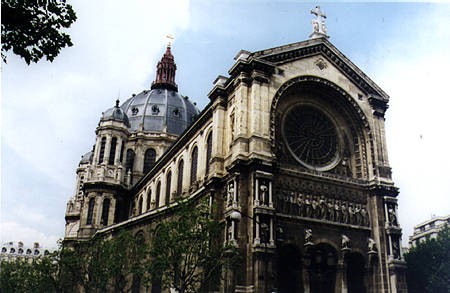During the second Empire, this neighbourhood, known as 'little Poland', underwent significant redevelopment following construction work by Haussmann – broad straight avenues were laid out and people flocked to live in the new houses built there, greatly increasing the population. A parish was therefore established and a church built, and great care was taken that the church matched the elegance and wealth of the surrounding housing. The architect called in to design Saint Augustin was Victor Baltard, famed for his previous work on the Halles de Paris.
The triangular shape of the site, marked out by the meeting of the streets rue César Caire and boulevard Malesherbes, dictated the form of the building, giving it a narrow façade fronting an enormous nave (without side-aisles) progressively widening to an octagonal transept flanked by chapels and topped by a dome with a windowed lantern. In addition to all this, the building's most striking innovation was its metal frame structure. The church was in fact the first building of such a size (300 ft long and 240 ft wide) to be built of iron and steel, very popular building materials during the second half of the 19th century. The metal frame, hidden under heavy stonework, can clearly be seen inside and it even forms part of the decoration, notably Schoenewerk's iron angels at the tops of the pillars.
The construction work on the church lasted eleven years from 1860 to 1871 and the decoration, inspired by Romanesque and Byzantine art, was supervised by Baltard himself. The triple-bayed porch was ornamented with a frieze by the sculptor Jouffroy depicting Christ and the Apostles. Above a gilded, wrought-iron rose window stretches to the top of the façade, following the line of a round arch. Inside, in the central part of the transept there is a sanctuary which is surrounded by a stone and marble parapet. Within this, there is an opulent wrought-iron ciborium and the main altar with its bronze grills, its marble columns and its Lyons mosaiques. Also noteworthy are the tapestries by Bougereau in the side chapels and the bronze statue of Joseph by Chapu. The sixteen figures painted on the underside of the dome are the work of Jean-Louis Bézard.
The Emperor himself chose the the church as the site for his tomb, and so it is here, in such a perfect representation of second empire style, with its metal structure and eclecticism, that those who wish the remains of Napoleon to be repatriated to France, desire that the sovereign's body should be laid to rest.
Saint Augustin Church


